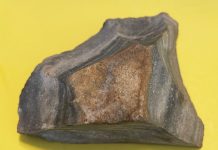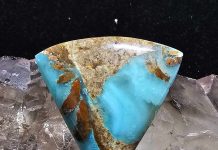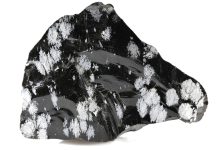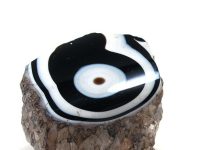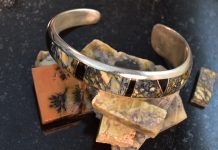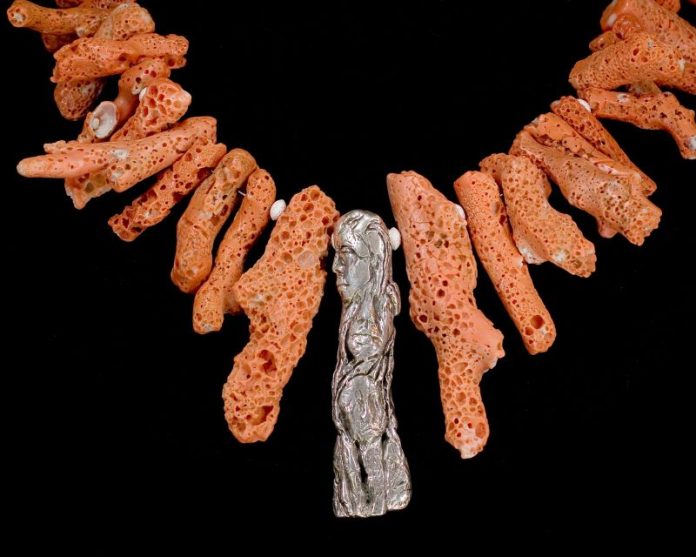
Orange rocks and gemstones are always popular. They took center stage as the 2024 Color of the Year by the Pantone® Color Institute with Apricot Crush (#024-65-27). This color strikes a balance between yellow and red on the visible spectrum and continues to be a top seller.
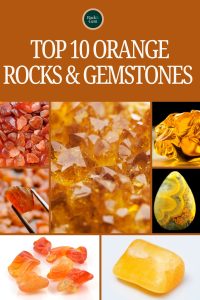
Utilizing matching orange rocks and gemstones keeps lapidary and jewelry collections fresh and current. It is a great way to find inspiration for new designs in the featured colors and proposed color combinations, even from the sophisticated, often poetic names.
Apricot Crush Lapidary Materials
A number of lapidary orange rocks and gemstones match the Apricot Crush color, including transparent gemstones, which are usually faceted, while opaque materials are often cut as cabochons, carvings, beads, eggs and spheres. Quartzes, garnets, tourmalines, sapphires, topaz and organic gemstones fall into that orange spectrum.
1. The Quartz Family
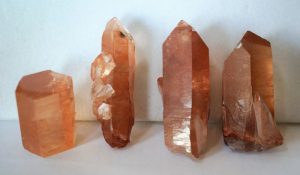
Photo by Helen Serras-Herman
Tangerine & Papaya Quartz: Iron-Stained Crystal Points
Papaya and tangerine quartz crystals are natural quartz crystals covered by an outer layer of iron. Some crystals may also have iron inclusions. The pinkish-orange stunning color of papaya quartz and the yellow-orange sunset coloration of tangerine quartz are natural on rare occasions, with the majority of tangerine quartz on the market created by “depositing metallic iron vapor, which instantly oxidizes to an orange color,” according to mindat.org. Most of these crystals come from Madagascar. They often exhibit perfect crystal terminations and are often used for metaphysical purposes.
Citrine Quartz: Heat-Treated for Deep Orange Glow
Citrine stone is the yellow-orange transparent quartz variety. All-natural color citrine is rare and usually pale yellow, lemon or honey yellow, while most of the citrine on the market today is heat-treated or enhanced in some way to produce a more-desired deeper orange-reddish coloration, which is a close match to Apricot Crush. Citrine is great for faceting and carving.
Drusy Quartz on Agate: Sparkling Sunset Orange Textures
Natural drusy quartz, which forms on top of agate, is perhaps the most common drusy material and was among the first materials used for drusy gemstones. Even though many agate geodes hold inside drusy quartz surfaces, only a small percentage has the quality to be cut into gemstones. Drusy quartz on agate is commonly found in gray colors, but occasionally in stark white, natural black, lavender and sunset orange. It may even exhibit black or brown dendrites (usually manganese inclusions) on top of the drusy. Citron chalcedony is the trade name for a cryptocrystalline variety of quartz (very small compact crystals), closely related to carnelian. The material is not commonly encountered and may fall under the carnelian umbrella.
Carnelian: Ancient Orange Chalcedony Gemstone
Carnelian is the brownish-orange-cherry red cryptocrystalline variety of quartz, known and used since antiquity as a gem material for engraved seals. Carnelian is a tough chalcedony with an even fracture (not conchoidal as in the crystalline varieties), which makes it easier to cut and polish without chipping. Carnelian is a great lapidary material, on the less expensive side compared to other chalcedonies, such as blue chalcedony or chrysoprase.
Carnelian occurs in many places around the world. Wonderful, richly-colored material comes today from Madagascar, but carnelian from Oregon, also referred to as Oregon carnelian agate, found at rivers and on the coast, exhibits a mix of varieties of colors ranging from honey-yellow to deep reddish-orange, often with some small drusy pockets.
Sardonyx: Banded Orange-Brown Chalcedony
Sardonyx is the banded chalcedony variety, with alternating layers of reddish-brown sard and cream onyx. Sardonyx is one of the most ancient gemstones used for engraved seals for thousands of years, and later for cameos. Material is found in Brazil, Germany, Madagascar and the United States.
Columbia River Agate & Flint: Rare Orange Quartz Varieties
Columbia River agate from the Washington-Oregon border is a cryptocrystalline quartz variety with deep cherry-orange colors, highly translucent material, mixed with common white opal and reddish-purple veins, making this material a truly unique member of the orange rocks and gemstones list. Although it’s called agate, it is closer to chalcedony, making it a great lapidary material.
Flint is another cryptocrystalline variety of quartz. It usually occurs as nodules and masses—often with a rough, thin, white skin layer—and has a glassy or waxy appearance. It was used in ancient times for engraved seals and for tools because the nodules knapped off easily.
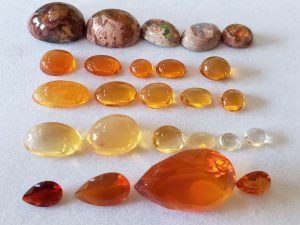
Photo by Helen Serras-Herman
2. Mexican Fire Opals
Fire opals from central Mexico, and more recently from Ethiopia and Australia, are beautiful orange rocks and gemstones. They occur in orange, red, yellow and brown colors, with or without play of color. Jelly, clean material is cabbed, faceted and carved, while material with opals embedded in the rhyolite host rock is cut into cabochons and all sorts of animal carvings.
3. Spessartite, Mandarin & Tangerine Garnets
Spessartite (also called spessartine) garnet is a manganese aluminum nesosilicate mineral. Spessartite, mandarin and tangerine garnets fall exactly in the deep orange-peach spectrum of orange rocks and gemstones that matches the Apricot Crush color, with slight hue variations between them. The name spessartite comes from the original discovery location at the Spessart Mountains in Germany. Most crystals are rather small and are commonly faceted with beautiful, brilliant results.
4. Imperial Topaz
Topaz is a silicate mineral of aluminum and fluorine. It occurs as colorless or light blue (the deep blue topaz is irradiated) and golden brown. The rare natural-color imperial topaz comes in yellow-to-pinkish-orange hues, usually found at the Minas Gerais pegmatite mines in Brazil. Topaz has a Mohs hardness of 8, making it a great lapidary material for brilliant, highly refractive faceted gemstones and carvings.
5. Oregon Sunstone
The Oregon sunstone comes from a few mines in the high desert area of southeastern Oregon. Sunstone is a member of the feldspar family, in the oligoclase, labradorite variety. Sunstone is Oregon’s official state gem.
The color ranges from almost clear/ yellowish, pale yellowish-orange, peach, pink, intense peach, red-orange, red, and pale green, to bi-colored red and green. The orange-pink hues closely match orange rocks and gemstones with the Apricot Crush color. The peach-pink color in Oregon sunstone is caused by a metallic glitter called schiller because of varying amounts and patterns of copper inclusions. Amazing carved and faceted gemstones are produced from this all-American material.
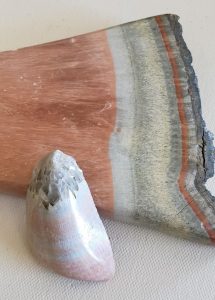
Photo by Helen Serras-Herman
6. Celestobarite
Celestobarite is an opaque material from Devon, England, chemically composed of strontium sulfate and barite. It usually comes with orange-pink or salmon-pink bands, and fibrous grayish-white and dark grey galena stripes. It is a soft material, easily cut with some care needed for persistent scratches. It results in eye-catching cabochons.
7. Orange & Padparadscha Sapphires
Sapphires are part of the corundum family, consisting of aluminum oxide. They come to the orange rocks and gemstones list in all colors of the rainbow, from colorless to black, designated as sapphires. The red ones are rubies, while the pink are sapphires. Orange sapphires are rare, and the natural-color pinkish-orange variety, known as padparadscha, is even rarer and extremely expensive. The name comes from Sanskrit, referring to a lotus flower.
Sapphires come from a number of places around the world. Sapphires from Montana are among the most beautiful and valuable transparent gemstones in North America. They come in every color of the rainbow and in the Apricot Crush hues. Sapphires are hard and durable, and faceted ones are the perfect complement to any jewelry design project. Hardness for all sapphires is Mohs 9.
8. Bumble Bee “Jasper”
Bumblebee “Jasper” from Indonesia is a brightly colored orange and black material, with a fierce look and equally deadly chemical composition. The material displays a dramatic sequence of concentric or wavy bands of ochre, black, yellow-green and orange colors, along with white veining, against the translucent tan or grey background matrix. The manganese-rich jet-black layers are a stark contrast to the orange/yellow bands and create a stunning visual.
Dominated by soft minerals such as calcite, aragonite, anhydrite, orpiment and realgar, bumble bee jasper is softer and much less durable than other highly silicified jaspers. The lower hardness makes the material relatively easy to cut and polish. However, the intense brilliant yellow and orange coloration comes from the minerals orpiment and realgar. These are arsenic-bearing minerals high in sulfur content and toxic to work with. When cutting and polishing this material, take all possible precautions to avoid ingesting or inhaling toxic dust. Cut with water and wear a respirator mask.
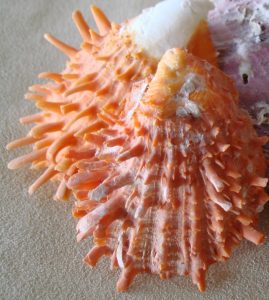
Photo by Helen Serras-Herman
9. Coral & Spiny Oyster
Corals are created by colonies of small animals (polyps) that secrete a limestone substance. The growth of the coral branch is slow, the result of continuous sedimentation of calcium carbonate. The science behind corals was established in 1864 by Henry Lacaze-Duthiers.
The Mediterranean coral (Corallium Rubrum), famous for its red and light-salmon colors, is fished in the Mediterranean and the Tyrrhenian Sea, along the coasts of Italy, Morocco, Tunisia, Corsica and Spain. The Pacific coral (Corallium Elatius) is fished along the coasts of Japan, Taiwan and Hong Kong. It commonly comes in massive sizes, usually with a white central vein.
Spiny oyster is the the spondylus genus of a bivalve mollusk, and a favorite Native American jewelry gem material since pre-Columbian times. The orange color closely matches the Apricot Crush color.
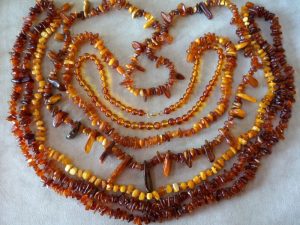
Photo by Helen Serras-Herman
10. Amber
Amber is another organic material, a plant resin originating from coniferous trees, which lived between 320 and 60 million years ago. Amber is found in several places worldwide in a variety of colors, but amber from northern Europe collected around the Baltic Sea shores is considered the best quality, with its golden-orange color closest to the Apricot Crush color. Amber’s hardness is between Mohs 2.0 and 2.5. Amber ranges from transparent to sub-translucent to opaque.
Amber and coral can be cut and carved with simple steel tools, such as saws, files, and knives or metal burrs. Sanding can be done with sandpaper of various grits preferably with water to avoid heating.
This story about orange rocks and gemstones previously appeared in Rock & Gem magazine. Click here to subscribe. Story by Helen Serras-Herman.


